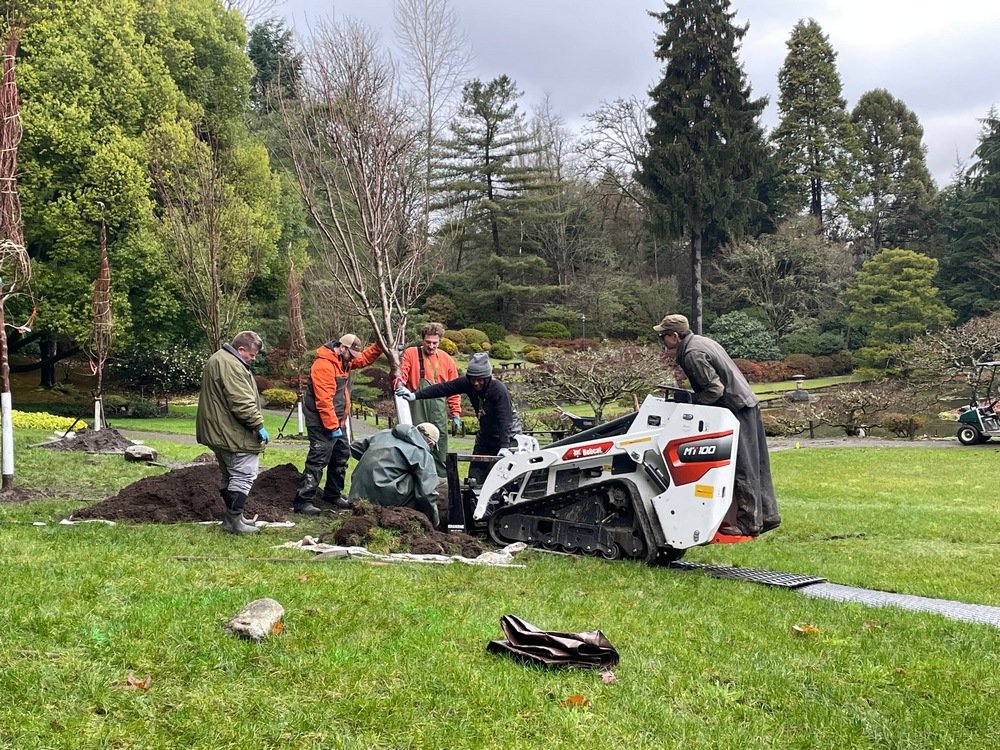New Flowering Cherries Planted in the Restored Meadow
By Niall Dunne
Seattle Parks and Recreation crew planting a cherry tree in the restored meadow. (Photo by Jose Gonzales)
Last month, the garden crew from Seattle Parks and Recreation completed the final phase of the meadow restoration project in the Japanese Garden. This involved the planting of 11 beautiful new flowering cherry trees in the upper section of the meadow, which overlooks the Moon Viewing Platform by the Garden’s pond. Funding for the tree planting came via a gift to the Arboretum Foundation from the family of Nobuko Anderson, a long-time Garden volunteer.
The trees are all about 10 years old and already relatively big—between 12 and 15 feet high. The crew fork-lifted each specimen to the meadow, using heavy-duty mats to protect the new turfgrass.
Head gardener Pete Putnicki attaching tripod staking to a new cherry tree. (Photo by Niall Dunne)
“This is a big space to fill, so we chose to plant pretty sizable young trees,” says head gardener Pete Putnicki. “They were grown in ground at the nursery—as opposed to in containers—and the root balls were nice and big, about 30 inches in diameter. We bermed up the planting holes to help with drainage but also because new plants tend to settle a bit. We then created large mulched rings around each tree to protect them from foot traffic for the first few years.”
The crew used granite block markers to help hold the soil berms in place and also constructed eye-catching wooden tripod staking to support each tree until the roots are established.
‘Accolade’ and ‘Snow Goose’
Prunus ‘Accolade’ blooming at the north end of Azalea Way. (Photo by Niall Dunne)
The new planting is comprised of two hybrid cultivars that grow reliably in our region: Prunus ‘Accolade’ and ‘Snow Goose’.
‘Accolade’ grows to about 25 feet tall with a relatively open crown. Dark-pink buds open to soft-pink, semi-double flowers in March. The bark is attractive, smooth, reddish-brown, and marked with horizontal lenticels. Two specimens of this cultivar have been putting on a lovely show at the north end Azalea Way in the larger Arboretum for more than 50 years!
‘Snow Goose’ is a more upright tree, growing to 20 feet tall. It also blooms early in the season, bearing pure-white, single flowers before the foliage appears. Mature specimens have beautiful, coppery-red, glossy, peeling bark.
“We went with just two cultivars,” say Pete, “because our priority with this planting was to create a beautiful ornamental composition, more than a botanical collection.”
Restoration Complete
The tree planting is the culmination of a restoration project that began more than a year ago, when the gardening crew completed the initial regrading of the meadow to fix long-term drainage issues caused by years of compaction and sub-surface changes.
“The drainage problems caused us to lose a lot of the original cherry trees to soil-borne fungal pathogens,” says Pete. “Two drainage lines have now been installed to solve this issue, plus we have new soil, and the trees are now higher upslope, which will further enhance drainage conditions.”
The regrading project also created a flatter area at the base of the meadow that will be more user friendly for special events—and will also provide visitors with a more even spot from which to enjoy and admire the flowering cherries.
“The trees all have flower buds on them right now,” says Pete. “I can’t guarantee that they’ll bloom this spring—and our primary goal is to get the plants established for the long-term—but you never know!”
Niall Dunne is the editor of the “Arboretum Bulletin” and the communications manager for the Arboretum Foundation.



